|
I wrote this article in early 2000 and it is now somewhat dated, particularly the discussion on digital cameras. I've left it on my site because I think it is still useful, but keep in mind that digital technology has progressed significantly since then. Digital point and shoot cameras are now as effective as film P&S cameras. Digital SLRs have enough quality to replace 35mm film SLRs for most applications, and have essentially replaced film SLRs for news, sport, and event photography. This article is aimed at enthusiastic hobbyists (I'm assuming pros are well beyond this) that take photography seriously, and want additional information to help them make a camera system selection. Of course, I should say right up front that the photographer is much more important than the camera - it's possible to take artistically rewarding images with any camera, and its easy to take terrible photographs with the most expensive pro camera. There are many factors to consider in selecting a camera system. It is a major investment and will likely be a decision that you will live with for many years. FormatThe first decision you need to make is what format you want to use. There are pros and cons to each format which I'll try to enumerate here. I've also included point-and-shoot film and digital cameras as separate categories so that you can see how these compare as possible choices.
Point and ShootP&S cameras are designed for casual photographers that don't want to think much about focus, exposure, film type, etc. They generally have very limited controls, mediocre quality optics, poor focus mechanisms, and no flexibility. The advantage compared to other camera types are size and weight, ease of use, and cost. If you want a camera to take quick snap shots of family events, this isn't a bad choice. If you want a camera that will give you control over the photographic process, skip the point and shoots. APS
35mm
As an extra camera to carry with you when you can't carry your primary rig, they can be a reasonable investment, particularly the better ones such as the Contax TVS II or III. These Contax cameras have good focus mechanisms, exposure compensation and aperture priority mode. They also have a fairly high quality zoom lens and are capable of excellent photographs. Digital
Digital P&S cameras are recommended as a secondary camera or to get more familiar with what digital is capable of, but are not recommended as your primary camera for serious photography. APS SLR
The biggest downside is the film format - small film size and none of the more interesting films.
35mm Rangefinder
Rangefinders are well suited for applications where small size and wide angle to standard focal lengths are important. I don't personally use a rangefinder so I don't know all the advantages of this format. 35mm SLR
The most popular 35mm SLR camera systems offer flexible operation with many convenience controls such as auto-focus, high speed auto wind and rewind, sophisticated matrix metering, through the lens flash metering, auto bracketing, depth of field preview, shiftable program mode, and more. They also offer a wide range of lens choices from super-wide angle (14mm and wider) to super telephoto (600mm and longer), zoom lenses and fixed lenses, and even shift lenses and image stabilization lenses. For most serious hobbyist who wants to take a variety of photographs, this is the camera type to get. It is a good or best choice for every photographic application (see chart above). It is particularly well suited to applications which require long lenses (wildlife, sports) and fast response (fashion). And the top camera systems have been available for many years now so there are plenty of available used products to go along with the latest technical wonders. Medium Format
The latest MF cameras from Pentax, Mamiya and Contax have most of the key features available on 35mm SLRs including autofocus, program exposure mode, depth of field preview, mirror lock up, exposure compensation, exposure bracketing, autowind, etc. Where they fall short is in their speed (film advance and focusing speed are considerably slower than current pro 35mm SLRs), metering sophistication, and lack of lens choices (particularly very long). These cameras are generally designed for photographers that can take a little more time setting up a shot. As such, MF cameras are not well suited to sports, wildlife, event photography, and candids. MF cameras are also somewhat bigger than 35mm SLRs, particularly if you consider the larger MF formats such as 6x7 and 6x8. Many photographers may consider them too large and heavy to travel with. The primary advantage of MF over 35mm is the increased film size. The 6x4.5cm format is roughly 2.7 times the imaging area of 35mm film. This makes a significant difference when creating large enlargements, particularly larger than about 16x20. Despite the disadvantages of MF, my Contax 645 is my favorite all-around camera. Its got most of the convenience features of my 35mm setup; its well balanced and easy to use; the image quality is a significant step up from 35mm; and its significantly easier to cart around and set up than my large format 4x5. However, my bias is toward landscapes for which the MF is reasonably well suited. Compared to large format, the MF is significantly faster to use, but lacks the movements (tilt and shift) that make the large format so powerful. There are a few exceptions to this latter limitation, but these cameras are closer to large format view cameras (just a little smaller) than they are to traditional MF cameras. Large Format - 4x5 or larger
In most cameras, such as P&Ss, rangefinders, SLRs, etc., the lens position is fixed with respect to the film plane. The only movement available is for focusing. Almost all large format cameras, on the other hand, have a significant degree of flexibility regarding the position of the lens with respect to the film plane. These camera capabilities are typically referred to as camera movements. Large format cameras are often referred to as �view cameras�, although this term is also sometimes used to refer only to one category of large format camera � the monorail camera. The other common category is called the field camera or flat-bed camera. Monorail cameras provide the most flexibility. Field cameras are a little lighter and more compact. The camera movements allow the plane of focus to be changed so that it does not have to be parallel to the film plane, and also allows the perspective to be changed. For example, by tilting the lens board (called the front standard) forward, it is possible to get the foreground and background in focus at the same time with a relatively wide aperture. By keeping the film plane perpendicular to the ground and shifting the front standard up, you can get a an upward looking view without the perspective error that results from doing this in a camera without these movements. The most flexible monorail cameras allow significant tilt, shift and swing (rotation of the standard) on both the front and rear standards, providing the photographer with almost unlimited control over depth of field and perspective. A large format camera forces you to slow down as a photographer, and to really pay attention to what you�re photographing. They don�t have autofocus or matrix metering (or any metering for that matter); everything is completely manual. I�ve found that this has really helped me concentrate on what I was doing � I don�t waste as much time taking photos that I�m not confident in. In fact, using the view camera has even helped my photography with my other cameras. Digital Backs and BodiesMost of the pro formats discussed above have digital bodies (35mm) or digital backs (medium format, large format) available to allow you to make a choice between film and digital after you've selected a camera system. Currently, pro-quality digital bodies and backs are significantly more expensive than their film-based equivalent (adding between $5000 and $25,000 to the cost of the system). Unless you have significant disposable income or are a very serious amateur or professional (or both), this is probably not an option that should be considered until the prices become more reasonable. Features to Look ForI've tried to list the features I think are important (particularly in a 35mm SLR) in more-or-less priority order. Let me know if you think I've forgotten any key features. Manual Exposure - being able to set a specific exposure (aperture and shutter speed) is critical to give you the flexibility required to create the image you're looking for. If necessary, you can get away with a camera that allows you to set the aperture and then adjust the exposure (using exposure compensation) instead of setting the exposure explicitly, as long as both aperture and shutter speed are displayed.Exposure Compensation - this lets you adjust the exposure when you're in aperture priority mode, shutter priority mode or program mode. Very valuable for compensating for a scene that you know will be metered incorrectly (such as a very dark or very light scene). Spot Metering - most cameras have a center weighted averaging meter, but it's very useful to also have a built in spot meter that can help you determine the correct exposure for a complex scene. Of course, you can always use an external spot meter assuming the camera has manual exposure and if you have the time. Depth of Field Preview - this is only relevant for SLR cameras. It allows you to stop down the lens to the aperture that the photo will be taken at so that you can see the actual depth of field. Unfortunately, this also reduces the amount of light coming through the lens, so the scene will often be too dark to check the depth of field except for close to wide open apertures and bright sunshine. Autofocus - the value of autofocus depends on your personal preferences and the kind of photography you're going to do. It's particularly important for fast moving objects (such as wildlife, sports, candids), but I also find this feature very helpful for all photography since I don't have to worry as much about focus and can concentrate on other issues such as composition and exposure. Focus Lock - focus lock is a helpful feature if you have autofocus. This allows you to aim the camera at the focus point, then reframe to shoot the picture. Focus Zones - another helpful variant of autofocus which allows the focus point to be off center without requiring reframing. Exposure Lock - this is helpful particularly if you have spot metering. The internal spot meter can be used to take a reading on a neutral part of the image, then the scene can be reframed without the exposure changing. Mirror Lock-Up - The mirror in an SLR can cause vibration when it flips up as your taking a picture, and cause a reduction in image sharpness. This is particularly noticeable with long telephotos and close macro shots. Some cameras have the ability to lock the mirror up so that it will not have this affect. I prefer cameras which allow you to set up the self timer to lock up the mirror for 2 seconds before the shutter trips. Cameras that use a separate lever for this are harder to use. Matrix Metering - If you're going to use the camera for action shots where you won't be able to take the time to carefully determine exposure, a good matrix metering system can really make the difference between a lot of keepers and a lot of rejects. This is one of the areas where there is a significant difference between the pro cameras and consumer cameras. Film ISO Setting - Most modern cameras have auto DX reading from the film canister. But it is sometimes desirable to expose the film at a different ISO, such as when you are pushing the film. If the camera has exposure compensation, you can fudge the exposure this way, but it's a lot more convenient to just be able to set the ISO rating at whatever you want. Which Brand?There are many excellent products available today and I certainly don't have experience with all of them, or even most of them for that matter. I have, however, done a fair amount of research as I've looked for the products I've wanted to buy. So, I'll share some of my thoughts here but keep in mind that 1) this is based on the aspects of a camera system that I found important which may not match your priorities; 2) I have not investigated every brand; and 3) my information is not necessarily current since this market changes very fast. RangefinderI don't have a lot of experience here and don't currently own a rangefinder. The two camera systems that my friends have and like are the Contax G2 and Leica M6. Both seem like excellent products and take beautiful photographs. 35mm SLRThere are seven major brands of 35mm SLRs - Nikon, Canon, Minolta, Pentax, Yashica, Contax, and Leica. Any of these brands will probably serve you well, but if I were choosing a new camera system, I'd limit the choice to Nikon, Canon, Contax and Leica - the first two for the breadth of their systems and technological sophistication; the latter two for their excellent optics and precision build quality. Minolta, Pentax, and Yashica have all but abandoned the pro market and are no longer significant technology innovators. You'll probably be very happy with a camera from one of these manufacturers (particularly Minolta) but I see no significant reason to choose one of these brands over the other four. (Note that Yashica and Contax are both made by Kyocera - Yashica is essentially the budget brand). Contax and Leica SLRs are manual focus cameras (although Contax does have one model, the AX, with an ingenious autofocus mechanism built into the body which actually shifts the position of the film plane). They lack some of the advanced features found on Nikons and Canons such as evaluative matrix metering and image stabilization lenses, but they have superb optics. Leica has the reputation of having the best optics in the world. They also have the highest prices. Contax, with its Zeiss optics, is a close second on both counts. I don't have personal experience with Leica's SLR bodies and lenses, but my son has a Contax system (RX and Aria with several lenses). It seems to be an excellent system with great optics. If you can do without autofocus and some of the other "advanced" features, and can afford the cost, this system is worth considering. The two industry leaders are Canon and Nikon. Most pros use one or the other of these systems. Their respective pro bodies are easy to use, robust workhorses. They each have excellent lens systems with about every kind of lens you could ever want (Nikon's lenses range from 6mm to 2000mm). There is also a very extensive third party market making products for these two systems. Canon and Nikon seem to play leapfrog with technology leadership. Canon has clearly been ahead with their lens technology (Image Stabilization, USM, shift) over the past few years, but Nikon is catching up in all these areas. Nikon has had the lead in camera bodies with the F5 and F100, but Canon has now caught up with the EOS 1V and EOS 3. Nikon is currently ahead on the digital front with the excellent D1 but I hear rumors that Canon is not far behind. They both seem to have comparable optics - Canon will have a better lens at one focal length, Nikon at another. Canon seems to have richer features in their low end cameras than Nikon. If you're getting started on a budget, this is certainly something to consider. In their higher end cameras, I think it's a dead heat. When I got serious with my photography hobby about ten years ago, I started out with the Canon EOS system - the EOS 10S and then the EOS A2E. About three years ago, I decided to invest in underwater camera equipment, specifically getting a housed SLR system. I couldn't find a housing I liked for my A2E, and since I had never made a serious investment in lenses with this system (primarily buying non-pro Sigma lenses), I was willing to switch to a new system. At the time, the Nikon N90S had the best underwater housing support. So I started with this body and started building a new system; this time going for higher quality lenses. As you can see from my Equipment page, I'm financially committed to Nikon at this point :-). If I had to choose between Nikon and Canon today, I'd probably choose Canon, primarily because of the availability of the IS lenses, and since there are now a few good underwater housings for Canon bodies. But the Nikon D1 would make this choice really hard, and once Nikon's 80-400mm VR lens is available, I will probably change my mind on which I'd choose if I were starting over. But I don't regret my choice of the Nikon - I've been very happy with the system and I'm sure the technology lead will switch back and forth between Canon and Nikon again in years to come. Medium FormatI selected the Contax 645 because I wanted an autofocus camera with the key features I found important on my 35mm SLRs. These were depth of field preview, mirror lockup, exposure compensation, spot metering, and both manual and automatic exposure. When I made my selection, there were two autofocus MF camera systems available � the Pentax 645N and the Contax 645. I chose the Contax because I liked the feel and felt the Zeiss optics would likely be a little better (can�t say if this is actually the case). Since then, Mamiya has also come out with an autofocus MF. This appears to be an excellent system. I�m very pleased with the Contax camera and would give it a strong recommendation. The only aspect I�m not happy with is that it chews through batteries and uses the 2CR6 lithium batteries that are not always easy to find. The Pentax and Mamiya systems have one significant advantage over the Contax � they can use the vast array of lenses and accessories designed for the earlier MF cameras from these companies. The Contax 645 is Contax�s first foray into MF. If you don�t care about autofocus, there are a lot of choices including 6x4.5, 6x6 and 6x7 cameras from Pentax, Mamiya, Bronica, Rollei, Hasselblad and Fuji. I don�t really have a lot of experience with these cameras so shouldn�t comment on my preferences, but one of the cameras I�ve looked at with serious interest a few times is the Fuji GX-680 III. This camera has a nice large 6x8 film format (almost twice the size of the 6x4.5 cameras) and tile, shift and swing of the front standard, giving it a lot of the flexibility of a view camera with the convenience of an advanced MF (motor drive, built in metering, etc.). Large FormatI know even less about the various options for large format. I chose the Linhof Technikardan 45S based on the recommendation of some pro photographer friends and my local dealer. I also looked closely at the Toyo VX-125. I chose the Linhof in the end because of the number of available accessories and I found it a little easier to understand how to use. LensesThe choice of lenses to get with your camera (assuming it has removable lenses) depends a lot on the kind of photography you�re interested in. Starting OutA lot of camera packages (except for the pro packages) now come with a low-priced zoom lens that covers a range of 28-80mm or so. If you�re serious about photography, I�d recommend against buying this kind of lens. While this kind of lens will allow you to experiment with a variety of focal lengths, you�ll soon grow disappointed with the quality of the optics. I still believe the best choice to start out is a simple inexpensive 50mm lens. The quality of these lenses is superb and the price is quite low. Starting with this lens will also help you make you a better photographer by allowing you to focus on the fundamentals of exposure and composition. Many photographers with zoom lenses tend to use the zoom in lieu of moving to the right spot to take a photograph. Starting with a 50mm lens gets you out of this habit quickly. Lens QualityFixed focal length lenses will deliver better quality, often substantially better, than zoom lenses. Check out PhotoDo to see detailed lens resolution test reports. A standard Canon 50mm f1.8 lens, for example, has an overall grade (on a 1-5 scale) of 4.2 (excellent) and the price of this lens is only $85. The best pro zoom lens from Canon covering this range is the 28-80mm f2.8 which only has a grade of 3.9 (very good) and costs $1200. Canon�s budget zoom, the 28-80mm f3.5-5.6 has a grade of 3.2 (fair) and costs $130. The really wide range zooms, such as the Tamron 28-300mm f3.5-6.3 only have a grade of 2.6 (pretty poor) and sell for $500. These grades (from PhotoDo) indicate lens resolution, but geometric distortion, low contrast, color aberrations, and lens flare are also serious problems that get progressively worse as you go from quality fixed focal length lenses to budget wide-range zoom lenses. Zoom lenses do have their advantages � fewer lenses are required to cover a range of focal lengths which reduces travel weight and size, and potentially cost; for applications which require quick focal length changes (wildlife, sports, events), zoom lenses can make the difference between getting the shot and not. My FavoritesWide Angle � I shoot mostly landscapes and use a wide angle lens more than any other. For 35mm, I like the 20mm fixed focal length lens. For MF, I use a 35mm lens. These are fairly wide angle lenses, but can still be used effectively without creating extremely exaggerated perspective. Standard � A significant percentage of my medium format photographs were shot with my 80mm standard lens. I don�t tend to use the �standard� focal length as much with my 35mm since most of the shots where this focal length is appropriate I shoot with my MF. Macro � I use my 60mm and 105mm macro a lot, particularly for underwater and flower photography. The 105mm is great because if provides a little more working distance, but still allows focusing down to 1:1. Telephoto � A medium telephoto (135mm for 35mm, 210mm for MF) is great for pulling in detail for landscapes when you can�t move closer. Long Telephoto � Big Glass as they�re known by those who have to cart them around a lot are very useful for wildlife photography. Large apertures allow you to keep shutter speeds high enough to capture action and minimize the effect of lens/camera shake. This also allows short depth of field to isolate your subject from the background. I use a 400mm f2.8 lens with a 1.4x and 2x teleconverter. I also have a 300mm f4 lens for hand-holding when I�m trying to track a fast moving subject such as a bird in flight. Ultra-Wide Angle � Lenses in the 14mm range can be a lot of fun to play with and can create some very interesting effects, but the extreme perspective limits their application. Wide-Angle Zoom � When I�m feeling lazy and only want to carry one lens on a hike, my 17-35mm f2.8 is the one I take. This lens is almost as good as my fixed focal length lenses in this range, but costs as much as 3-4 fixed focal length lenses. Midrange Zoom � A 28-70mm f2.8 zoom is useful for event photography since it provides a range from wide angle to moderate telephoto. When you can�t afford the time to change lenses between shots or don�t want to carry a camera bag, this is a nice lens to use. As stated previously though, it�s a compromise in quality compared to fixed lenses. Telephoto Zoom � The 80-200mm f2.8 zoom is popular for wildlife, particularly when you can get close to the animals. Lenses for a BudgetI�ve talked about what lenses I think are useful, but for most people the question is what lenses should I buy given a budget of $_____. So here are my recommendations based on the kinds of photos I take (in priority order � landscape, candids/events, wildlife). I�ll use B&H prices for Nikon lenses as an example. A similar selection could be put together for other camera brands. Grades are scores from PhotoDo.com's website. $100 Budget
$350 Budget
$600 Budget
$1000 Budget
$2000 Budget
$3000 Budget
$5000 Budget
$10,000 Budget
Important AccessoriesHere are a few accessories that you might consider. TripodThe most important accessory is a tripod. It is impossible to get the sharpest images without using a tripod (or some equivalent). Using fine grain film (such as Fuji Velvia) at medium apertures (f11 or f16) results in shutter speeds that are 1/30th second or slower. Even with a very wide angle lens, this is too slow to hand hold and get the sharpest results. I have noticed a difference in photographic sharpness even at higher shutter speeds. If your subject and shooting conditions permit, use a tripod. Don't bother with the flimsy $50 tripods. If you can wiggle the head with your hands while the legs are extended, it's not going to provide enough support for your camera. See my equipment section for some suggestions on high quality tripods. FlashA high quality electronic flash can make a significant difference to the quality of your photographs, even in bright sun light. The flash that is built into some cameras is almost useless because of the low light output and the fact that it is so close to the camera lens. A more powerful flash that can be separated from the camera will give you much more flexibility and higher quality images. In daylight, a flash can be used add fill light to remove harsh shadows and to light a dark object against a bright background. It can also be used to add a catch-light to the eyes of people and animals that you're photographing. FiltersI usually leave a high quality skylight filter on my lenses (except the ones that don't accept filters) to provide protection against scratches, dust, and moisture. It's a lot easier and less expensive to replace a $50-$100 filter than a $500-$5000 lens. I get the best quality filters I can buy since I've found that less expensive filters do reduce sharpness and contrast. If you're shooting black and white, you should consider getting at least a yellow, orange, or red filter to darken the sky and add a little more drama to landscapes. For color, the two most useful filters are the polarizer and the warming filter. The polarizer can add more snap to colors and reduce glare on reflective surfaces such as water. The warming filter is helpful when taking photographs in the shade, which would otherwise come out with a bluish hue. Another useful filter (although one I don't use very often) is a split neutral density filter (or set of filters). This will allow you to effectively deal with the dynamic range of film when shooting a scene with a dark foreground and light background. When you use filters, try to avoid stacking them. Don't leave the skylight filter on when you put on the polarizer. Now matter how good the filter is, it will have some negative affects on the photograph. Stacked filters also risk vignetting.
Where to BuyIf you don't know what you want, I recommend you find a local dealer that can show you the options. There is nothing like holding a camera in your hand to get a feel for how well it will meet your needs. However, I don't think it is fair to a retailer to take up their time and leverage their inventory to decide what you want and then order it from a mail order company. If you want to see before you buy, buy from a local retailer, or go to a camera show where the manufacturers are showing their products to decide what you want. One of the local dealers in my area that I've found particularly helpful is Glazer's Camera in Seattle. They have a tremendous selection of equipment and a knowledgeable sales staff. And their prices are only slightly higher than the mail order shops. If you know what you want, I've had great luck with Camera World of Oregon and from B&H Photo and Video. Both have excellent prices (B&H is often a little lower), and are very reliable. Their websites are excellent, particularly B&H's. If the item is in stock (which is indicated on their sites), it will usually ship the next day. I can also recommend Camera Tech for underwater equipment. They specialize in underwater cameras and housings, and provided me with excellent advice on the best equipment to buy. They have also provided excellent service when I've had problems (underwater equipment is exposed to a much harsher environment than traditional camera equipment and will need more regular maintenance).
|

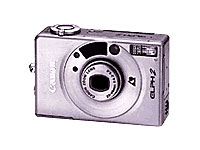 APS is an acronym for Advanced Photo System. This is a system designed by a
few film and camera vendors to make film cameras even easier to operate than
35mm P&Ss. But the APS film size is considerably smaller than 35mm resulting
in lower image quality. Also, many of the best films (specifically, transparency
films) are not available for APS. This does have the advantage of enabling
extremely small cameras that are very cute and practical to slip into a pocket
or purse. Since APS cameras are aimed primarily at the casual snap shot
photographer, these
cameras generally have almost no control flexibility.
APS is an acronym for Advanced Photo System. This is a system designed by a
few film and camera vendors to make film cameras even easier to operate than
35mm P&Ss. But the APS film size is considerably smaller than 35mm resulting
in lower image quality. Also, many of the best films (specifically, transparency
films) are not available for APS. This does have the advantage of enabling
extremely small cameras that are very cute and practical to slip into a pocket
or purse. Since APS cameras are aimed primarily at the casual snap shot
photographer, these
cameras generally have almost no control flexibility.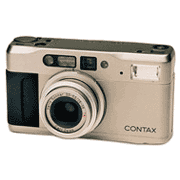 At least these cameras have the full 35mm film size. Some also have a fair
amount of flexibility in the controls (aperture priority, exposure compensation)
but they are still limited by lens selection, focus control and lack of features
such as depth of field preview.
At least these cameras have the full 35mm film size. Some also have a fair
amount of flexibility in the controls (aperture priority, exposure compensation)
but they are still limited by lens selection, focus control and lack of features
such as depth of field preview. 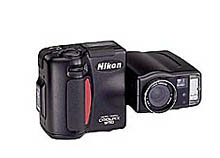 Virtually all the consumer digital cameras fall into the P&S variety.
Some of the newer prosumer cameras such as the Nikon Coolpix 950 (and soon to be
available 990) can take nice images (although not as good as a 35mm P&S at a
third the price) but these cameras provide very little flexibility and control
to the photographer.
Virtually all the consumer digital cameras fall into the P&S variety.
Some of the newer prosumer cameras such as the Nikon Coolpix 950 (and soon to be
available 990) can take nice images (although not as good as a 35mm P&S at a
third the price) but these cameras provide very little flexibility and control
to the photographer. 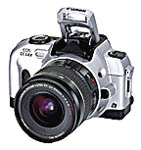 This format is almost an oxymoron, but if you want the control of an SLR but
aren't willing to deal with the size and weight, the APS SLR cameras such as the
EOS IX and Nikon Pronea may be worth considering.
This format is almost an oxymoron, but if you want the control of an SLR but
aren't willing to deal with the size and weight, the APS SLR cameras such as the
EOS IX and Nikon Pronea may be worth considering. 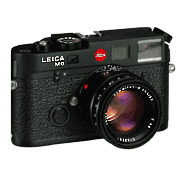 35mm rangefinders are very capable cameras. Many professional photographers
use them as their primary or secondary camera system. The rangefinder gives you
most of the control of a 35mm SLR with interchangeable lenses (although without
the same range as an SLR). The biggest advantage of the rangefinder over an SLR
is size and weight. A Leica M6 with a 50mm weighs just 30 oz., compared to 42 oz
for a Nikon F100 with an equivalent lens, and is significantly smaller.
35mm rangefinders are very capable cameras. Many professional photographers
use them as their primary or secondary camera system. The rangefinder gives you
most of the control of a 35mm SLR with interchangeable lenses (although without
the same range as an SLR). The biggest advantage of the rangefinder over an SLR
is size and weight. A Leica M6 with a 50mm weighs just 30 oz., compared to 42 oz
for a Nikon F100 with an equivalent lens, and is significantly smaller. 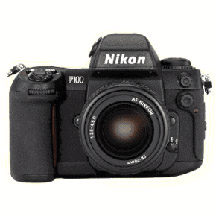 35mm SLRs are by far the most popular format for serious amateur
photographers and many professional photographers. This format has evolved to
become the most flexible and easiest to use camera type while still providing as
much control as most photographers require.
35mm SLRs are by far the most popular format for serious amateur
photographers and many professional photographers. This format has evolved to
become the most flexible and easiest to use camera type while still providing as
much control as most photographers require.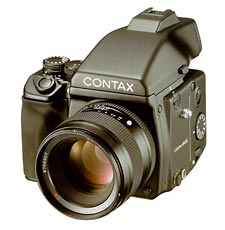 Medium
format refers to cameras which use 6cm wide roll film. There are a variety of
frame formats that use this film, including 6x4.5cm, 6x6cm, 6x7cm, 6x8cm, and
even 6x12cm panoramic cameras. The most common is 6x4.5cm, although the well
known Hasselblad cameras use 6x6cm.
Medium
format refers to cameras which use 6cm wide roll film. There are a variety of
frame formats that use this film, including 6x4.5cm, 6x6cm, 6x7cm, 6x8cm, and
even 6x12cm panoramic cameras. The most common is 6x4.5cm, although the well
known Hasselblad cameras use 6x6cm. 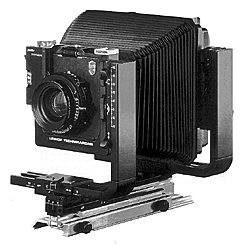 When
I first decided to get a large format camera, it was because of the larger film
format. I wanted to be able to create larger enlargements with high resolution.
What I didn�t realize at the time was the tremendous flexibility that is
provided by the camera movements.
When
I first decided to get a large format camera, it was because of the larger film
format. I wanted to be able to create larger enlargements with high resolution.
What I didn�t realize at the time was the tremendous flexibility that is
provided by the camera movements.